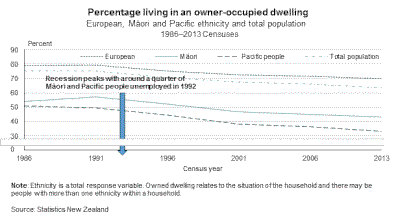Māori and Pacific peoples’ home-ownership falls in cities
Māori and Pacific
peoples’ home-ownership falls over 25 percent in cities
– Media release
9 June 2016
In the last 25 years, Māori and Pacific home-ownership rates fell at a faster rate than for the total population, Statistics New Zealand said today. The biggest drops were in the upper North Island, particularly the cities, where the fall was 25 percent or more.
In 1991, home ownership peaked nationally. Three-quarters of all people in households lived in an owner-occupied dwelling. At the time, around half of Māori and Pacific people lived in an owner-occupied dwelling.
The falls in home-ownership rates since 1986 were greater for Māori and Pacific people than for the total population – down 34.8 percent for Pacific people and 20.0 percent for Māori, compared with 15.3 percent for the total population. The declines were even larger in some bigger North Island cities.

Between 1986 and 2013, the proportion
of New Zealand’s population living in dwellings not owned
by the household increased from around one-quarter to over
one-third of the population (24.8 percent to 36.3 percent)
– up 46.4 percent. As home-ownership rates have declined,
Māori and Pacific people have also been increasingly living
in properties rented from private landlords, businesses, or
a trust, rather than from other sources.
Since 1986, the proportion of Māori living in private rentals has increased more than for the total population (up 88.3 percent and 42.7 percent, respectively). The increase for Pacific people was 58.5 percent.
The falls in home ownership did not just occur in our largest cities. For Māori, falls were close to 40 percent in the Whangarei, Southern Auckland, Tauranga, Rotorua, and Hastings urban areas.
The decline in home-ownership rates for all Pacific people in Auckland was similar, down over 40 percent in Western and Southern Auckland.
Changes in home-ownership patterns 1986–2013: Focus on Māori and Pacific people explores these and other changes in tenure patterns over more than 25 years.
Rosemary Goodyear, Statistics NZ researcher and the report’s author, says the report aims to provide extra information around changes in home ownership and give agencies working with Māori and Pacific people the information they need.
“We hope this information will be useful to policy-makers wanting to draft policy around home ownership and renting. Evidence shows us that people living in rented dwellings tend to experience more problems with housing quality and this can affect people’s health and well-being,” Dr Goodyear said.
ENDS


 Gordon Campbell: On The Public Sector Carnage, And Misogyny As Terrorism
Gordon Campbell: On The Public Sector Carnage, And Misogyny As Terrorism National Maori Authority: Maori Authority Warns Government On Fast Track Legislation
National Maori Authority: Maori Authority Warns Government On Fast Track Legislation NZ Government: Comprehensive Partnership The Goal For NZ And The Philippines
NZ Government: Comprehensive Partnership The Goal For NZ And The Philippines DoC: Canterbury Spotted Skink In Serious Trouble
DoC: Canterbury Spotted Skink In Serious Trouble Te Pāti Māori: Oranga Tamariki Cuts Commit Tamariki To State Abuse
Te Pāti Māori: Oranga Tamariki Cuts Commit Tamariki To State Abuse NZCTU: Inflation Data Shows Need For A Plan On Climate And Population
NZCTU: Inflation Data Shows Need For A Plan On Climate And Population Statistics New Zealand: Annual Inflation At 4.0 Percent
Statistics New Zealand: Annual Inflation At 4.0 Percent


